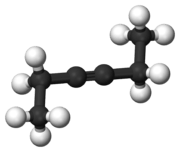3-Hexyne
 | |
 | |
| Names | |
|---|---|
| IUPAC name
Hex-3-yne | |
| Other names
Diethylacetylene | |
| Identifiers | |
| 928-49-4 | |
| 3D model (Jmol) | Interactive image Interactive image |
| ChemSpider | 12979 |
| ECHA InfoCard | 100.011.977 |
| PubChem | 13568 |
| |
| |
| Properties | |
| C6H10 | |
| Molar mass | 82.14 g/mol |
| Appearance | Colorless liquid |
| Density | 0.723 g/cm3 |
| Melting point | −105 °C (−157 °F; 168 K) |
| Boiling point | 81 to 82 °C (178 to 180 °F; 354 to 355 K) |
| low | |
| Hazards | |
| R-phrases | R11 R36/37/38 R65 |
| S-phrases | S16 S26 S36 S62 |
| Flash point | −14 °C (7 °F; 259 K) |
| Except where otherwise noted, data are given for materials in their standard state (at 25 °C [77 °F], 100 kPa). | |
| | |
| Infobox references | |
3-Hexyne is the organic compound with the formula C2H5CCC2H5, simplified to C6H10. This colorless liquid is the most common of the three isomeric hexynes. Together with 2-butyne and diphenylacetylene, it serves as a reference acetylenic ligand in organometallic chemistry. 3-Hexyne is useful because the 1H NMR signals for the methylene bridges convey stereochemical information in its octahedral complexes.
3-Hexyne (Diethylethin) forms with 5-Decyne (Dibutylethin), 4-Octyne (Dipropylethin) und 2-Butyne (Dimethylethin) a group of symmetric alkynes.
Properties
Spectral characteristics
In a proton NMR spectroscopy result, 3-hexyne produces a triplet of integrated area 6H at a chemical shift of approximately 1.0 ppm and a quartet of integrated area 4H at approximately 2.2 ppm. The less deshielded triplet corresponds to the terminal methyl hydrogen atoms that experience spin-spin splitting from the adjacent methylene hydrogen atoms. The quartet corresponds to the more deshielded methylene hydrogen atoms that are spin-spin split by the adjacent methyl hydrogen atoms. The methylene hydrogens don't form a complex multiplet because the internal alkyne function that is adjacent to them does not contain any bonded hydrogen atoms with which they can interact. The overall symmetry of the molecule causes both methylene bridges to contain hydrogen atoms in exactly the same electronic environment. The same logic follows to explain the identical spectroscopic results provided by the hydrogen atoms on all methyl groups.